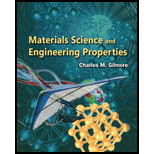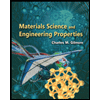
The comparison of theoretical density of silver at
Answer to Problem 2.5P
The obtained density of silver at
Explanation of Solution
Given:
The density of silver at room temperature is
The lattice parameter for is
Formula used:
Write the expression to find the number of atoms per unit volume.
Here,
Write the formula to find the density of silver.
Here,
Calculation:
Silver has the Face Centered Cubic (FCC) structure with
Substitute
The molecular weight of silver is
Avogadro’s number is
Substitute
Compare the obtained density of silver at
The obtained density of silver is less than the density of silver at room temperature.
Conclusion:
Therefore, the obtained density of silver at
Want to see more full solutions like this?
Chapter 2 Solutions
Materials Science And Engineering Properties
- Question 6 (of 8) 6. The density of platinum is 21500 kg/m³ and that of aluminum is 2702 kg/m³. Find the ratio of the volume of 1.80 kg of platinum to the volume of 1.17 kg of aluminum.arrow_forwardExplain which kind of microstructures you expect to observe at room temperature if an iron-carbon alloy of eutectoid composition is cooled down following the red and blue curves. 800 727° 700 Coarse pearlite 600 a+ FeC Fine pearlite 500 y+ a+ Fe,C 400 Bainite 300 M5- 200 so - Mo 100 1 sec 1 min 1 hour 1 day 102 103 104 105 0.1 10 Time, secondsarrow_forwardAt a temperature of 60°F, a 0.04-in. gap exists between the ends of the two bars shown in the figure. Bar (1) is an aluminum alloy (E-10,000 ksi; u= 0,32; a= 12.5 x10°/°F] bar with a width of 3 in, and a thickness of 0.75 in. Bar (2) is a stainless steel |E-28,000 ksi; u=0.12; a=9.6x10°/°F] bar with a width of 2 in. and a thickness of 0.75 in. The supports at A and C are rigid. Determine the normal stress in bar (1) at a temperature of 450°Farrow_forward
- A niobium alloy is produced by introducing tungsten substitutional atoms in the BCC structure. The lattice parameter and density of the alloy is 0.3285 nm and 12.25 g/cm3, respectively. Calculate the fraction of tungsten alloys. (AW = 183.85 g/mol, ANb =92.91 g/mol).arrow_forwardEnvironmental temperature has different influences on metals conductivity. Which one of the following statements is the most accurate? a. Copper conductivity increases significantly with the increase in temperature b. Electrical resistance of zinc increases at lower temperatures c. Electrical resistance of Iron increases dramatically at higher temperatures d. Electrical conductivity of aluminium increases dramatically at higher temperaturesarrow_forwardThe reciprocal of density isarrow_forward
 Materials Science And Engineering PropertiesCivil EngineeringISBN:9781111988609Author:Charles GilmorePublisher:Cengage Learning
Materials Science And Engineering PropertiesCivil EngineeringISBN:9781111988609Author:Charles GilmorePublisher:Cengage Learning
